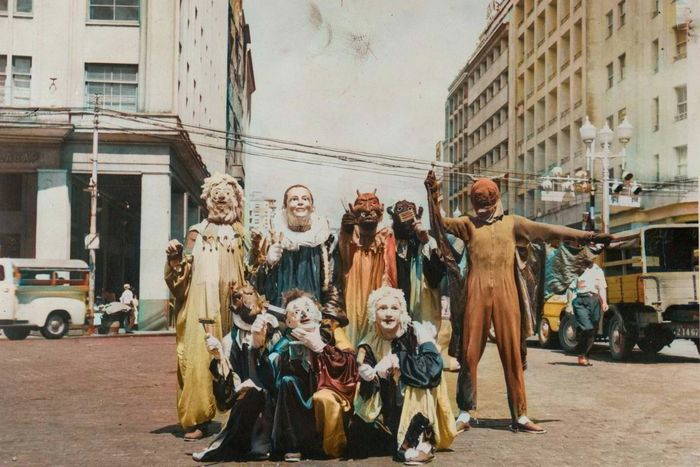
Recife, in northeast Brazil, is filmmaker Kleber Mendonça Filho’s birthplace, his home, and his recurring muse. When Filho, who began his career as a critic, began making scripted features, the dramas he constructed didn’t just take place in the city, but delved into its changing textures. Neighbouring Sounds explores the paranoia of middle-class residents in a developing area who are approached by a private security film, while Aquarius is about the ruthless efforts of a developer determined to throw out the last holdout in a grand old beachside apartment building. Filho’s beguiling new work, Pictures of Ghosts, is a documentary, one that makes explicit how personal the themes and images in his work are. It’s a meditation on architecture, history, and cinema, but it’s also about what it means to be a capturer and viewer of images that outlast the places and memories of what you’ve managed to place in your frame.
Pictures of Ghosts begins with the apartment Filho moved into when he was a child — a spot near the beach in Boa Viagem, which as Filho demonstrates by cutting between old photographs of the area from the ‘60s and current ones, is now dense with high rises and an influx of capital. He skips between time periods frequently in the film, which is part personal meditation and part historical essay, and which he narrates, weaving together shots of the present day with archival photos, old footage that he shot himself, and clips from movies by him and by others. Janet Leigh and Tony Curtis, on vacation decades ago, walk in dreamlike slow motion in black-and-white along the sidewalk of a downtown now hollowed out and half-abandoned. A ‘70s polyester sofa becomes a plush-armed present day one in the space of an edit.
Filho was apparently inspired to make Pictures of Ghosts when he and his family moved to a new place in the city, leaving behind that childhood home. He didn’t just grow up in that apartment, which represented a new start for his mother after her divorce — he shot movies there, both as a student and as a full-fledged filmmaker. The dog next door, forever barking, became an element in Neighbouring Sounds and made cameos on screen. Years after the animal’s death, Filho hears that familiar ruckus again, and realizes it’s audio from his movie, which is being shown on television and watched by his neighbors. Time may eventually come for everything and everyone, but the camera creates its own afterlife. Filho dredges up an old photo he took in the living room that has a mysterious blurred figure he describes as a ghost, but the specters that haunt his film are less literal — all that history that remains in spaces, even after that have been abandoned, revamped, resold, or demolished and rebuilt.
When Pictures of Ghosts leaves Boa Viagem for Downtown Recife, a once grand neighborhood that’s fallen into disuse (though it’s still home to Carnival), it finds more apparitions from the past in the form of the cinemas that Filho used to frequent. Most are gone, having undergone transformations into churches or retail spaces, their past lives preserved only in recollections and in old images. The temptation to get maudlin about the moviegoing past has been irresistible for filmmakers, but while there’s a certain amount of nostalgia to the way that Pictures of Ghosts regards the grand movie palaces of another era, the film’s prevailing sentiment is one of rueful bemusement at the way things change, and the way a building that was once one of the gravitational centers of your life can be awkwardly repurposed as a mini-mall. “It’s kind of sad to become attached to a product,” Filho muses. “The problem lies in the fact that you spent years of your life going to this cinema, so the relationship gets emotional and confusing.”
There’s a sense of loss there, but Filho isn’t interested in giving the past a rosy gloss. He includes his own deeply affectionate footage of Mr. Alexandre, the late projectionist at the Art Palácio, working shirtless to withstand the heat in the booth and talking about how sick he became of the score for The Godfather after it ran for four months. But Filho also doesn’t elide the fact that the Art Palácio, which now has a flower stand crouched under its crumbling edifice, was originally built to be a cinema for the German distributor UFA as a venue for Nazi propaganda (“Pretty good story,” he notes, wryly). That, too, is a layer of history lost under the patina of years. The question of what becomes of a filmmaker and film lover if the world moves on goes unspoken but is deeply felt. What happens if the medium that once drew 200,000 in Recife to see Hair in defiance of the government, who thought it anti-military, no longer merits the same huge spaces that were once dedicated to it? But Pictures of Ghosts is so lovely and alive that, if anything, it only reassures you that movies aren’t going anywhere.
More Movie Reviews
- The Thriller Drop Is a Perfect Addition to the Bad-First-Date Canon
- The Accountant 2 Can Not Be Taken Seriously
- Another Simple Favor Is So Fun, Until It Gets So Dumb


